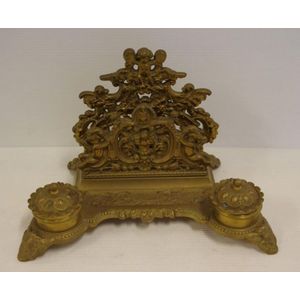Father and Son Lute Lesson Clock
You must be a subscriber, and be logged in to view price and dealer details.
Subscribe Now to view actual auction price for this item
When you subscribe, you have the option of setting the currency in which to display prices to $Au, $US, $NZ or Stg.
- Pendulum - The pendulum was discovered around 1602 by Galileo Galilei, and was adopted for time keeping by the Dutch mathematician and natural philosopher, Christiaan Huygens, who excelled in astronomy, physics, and horology.
The pendulum comprises a metal rod usually of brass or steel with a metal disk, known as a bob, at the end. The movement of the pendulum is driven by weights or a spring, and as a pendulum swings in a regular arc, it was found accuracy could be controlled to within a few seconds a week.
Timekeeping can be adjusted by changing the height of the bob on the rod, making the pendulum either swing slower or faster.
The disadvantage of the pendulum was that changes in temperature also changed the length of the pendulum, interfering with the accuracy of the clock, and so in the 18th century two types of mercurial pendulums were invented which countered the movement in the steel rod.
The pendulum was the world's most accurate timekeeping technology until the invention of the quartz clock, regulated by a quartz crystal, in 1927. - Bronze - An alloy of copper and tin, traditionally in the proportions of about 9 parts of copper to 1 part of tin.
The discovery of bronze in Western Asia in the 4th century enabled people to create metal objects which were superior to those previoulsy possible because of its strength and hardness, and it has been used throughout the world for weapons, coins, tools, statuary and other decorative items.
It is very fluid in a molten state, and its hardness, strength when set, and non-corrosive properties makes it most suitable for casting sculpture.
This item has been included into following indexes:
Visually similar items

Antique ormolu standish, with pottery ink wells, 30 cm wide

A Tibetan gilt-bronze figure of Buddha Shakyamuni, 15th century, seated in 'bhumi-sparsha'(earth-touching mudra) on a high double -lotus throne, a scroll inside the base, unsealed, Kasamala Kingdom, Western Tibet, 17.4 cm high

A possible 18th century superb gilt bronze Nepalese statue of Tara (mother of all Buddhas). The lower half and underside decorated with turquoise. Script to back of base. Height 27 cm

A French mantel clock, with black slate case, 8 day, two train movement, ormolu, depicting a young King and Knight on battlefield. Key wind pendulum driven, with key and pendulum, circa 1870. Height 58 cm. A/F ' glass cracked to back door and small chipts
